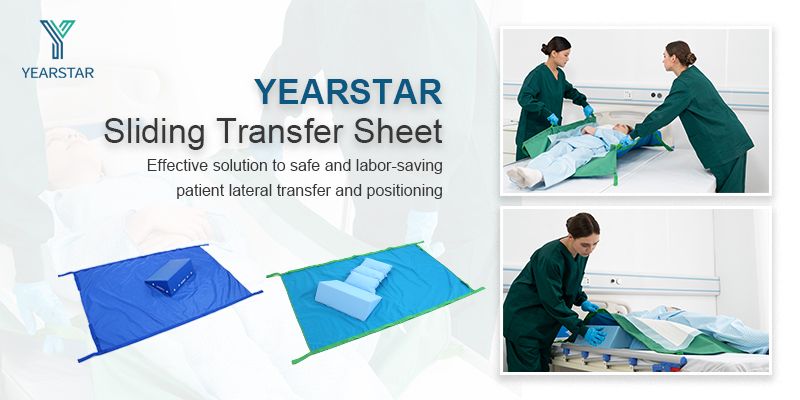Patient handling is a fundamental necessity throughout the entire healthcare continuum, not just in standard hospital rooms. From the fast-paced environment of the Emergency Department to the sterile field of the Operating Room and the critical setting of the Intensive Care Unit, safely and efficiently moving patients is paramount. While the core function of transfer sheets – reducing friction to facilitate movement – remains consistent, their specific applications and the benefits they provide adapt to the unique demands of each department. This post will explore the diverse ways transfer sheets are utilized across various healthcare settings, highlighting their essential role in optimizing patient care and staff safety.
1. The Universal Need for Safe Patient Transfer
Regardless of the department, the need to transfer or reposition patients arises constantly. This can involve moving patients from ambulances to stretchers, beds to procedure tables, or simply repositioning them in bed for comfort or medical procedures. Traditional manual handling methods in these varied environments present consistent risks of injury to both patients and healthcare workers. Transfer sheets offer a versatile solution to mitigate these risks.
2. Transfer Sheets in the Emergency Department (ED): Speed and Safety in High-Pressure Situations
The ED is characterized by urgency and a constant flow of patients with diverse conditions. Rapid and safe patient transfers are critical.
- Challenges in the ED: Diverse patient sizes and conditions, need for quick transfers, limited space, potential for uncontrolled movements.
- Transfer Sheet Applications in the ED:
- Moving patients from ambulance stretchers to ED beds/stretchers.
- Transferring patients to imaging equipment (X-ray, CT scan).
- Repositioning patients for assessments and procedures.
- Facilitating rapid transfers during critical events.
- Benefits in the ED:
- Increased Efficiency: Enables faster transfers, crucial in a time-sensitive environment.
- Enhanced Staff Safety: Reduces the physical strain on ED staff during frequent and sometimes challenging transfers.
- Improved Patient Comfort: Provides a smoother transfer experience for patients who may be in pain or agitated.
- Reduced Risk of Injury: Minimizes the likelihood of falls or skin damage during rapid transfers.
3. Transfer Sheets in the Intensive Care Unit (ICU): Managing Complexity and Fragility
ICU patients are often critically ill, with multiple lines, tubes, and monitoring equipment. Safe handling is essential to prevent dislodgement and ensure patient stability.
- Challenges in the ICU: Patient fragility, numerous medical attachments (IVs, ventilators, monitors), need for precise repositioning, risk of pressure ulcers.
- Transfer Sheet Applications in the ICU:
- Repositioning patients for skin checks, preventing pressure ulcers, and improving respiratory function.
- Lateral transfers to specialized beds or testing equipment.
- Assisting with small adjustments to patient position without disrupting critical lines.
- Facilitating complex turning procedures.
- Benefits in the ICU:
- Protection of Lines and Tubes: Allows for smooth movement that minimizes tugging or dislodging critical medical attachments.
- Reduced Shear and Friction: Vital for preventing skin breakdown in fragile and immobile patients.
- Precise Positioning: Enables controlled and accurate repositioning for medical procedures and comfort.
- Decreased Caregiver Strain: Reduces the physical effort required to move critically ill patients, who may be heavy or difficult to maneuver.
4. Transfer Sheets in the Operating Room (OR): Maintaining Sterility and Precise Positioning
In the OR, maintaining a sterile field and achieving precise patient positioning for surgery are paramount. Transfer sheets facilitate both.
- Challenges in the OR: Sterile environment, need for precise patient positioning on the operating table, limited space around the table, diverse patient sizes and surgical positions.
- Transfer Sheet Applications in the OR:
- Transferring patients from the stretcher to the operating table.
- Minor adjustments to patient position on the operating table before or during surgery.
- Transferring patients from the operating table back to the stretcher.
- Used underneath the patient during positioning to reduce friction and shear while maintaining skin integrity.
- Benefits in the OR:
- Maintains Sterile Field: Allows for patient movement without touching non-sterile surfaces or disrupting drapes (when used correctly).
- Enables Precise Positioning: Facilitates subtle and accurate adjustments to patient position on the table.
- Reduces Risk of Patient Skin Injury: Minimizes shear and friction during transfers and positioning on potentially firm or uneven surfaces.
- Protects OR Staff: Reduces the physical effort required for transferring and positioning patients in a confined space.
5. Transfer Sheets in Radiology and Imaging Departments: Efficient and Safe Transfers to Equipment
Transferring patients to and from imaging equipment like X-ray machines, CT scanners, and MRI machines requires moving them onto potentially narrow or rigid surfaces.
- Challenges in Imaging: Transferring onto narrow or rigid tables, need for accurate patient centering, managing patients with limited mobility or pain.
- Transfer Sheet Applications in Imaging:
- Transferring patients from stretchers or wheelchairs onto imaging tables.
- Adjusting patient position on the table for optimal imaging.
- Transferring patients back to stretchers or wheelchairs after imaging.
- Benefits in Imaging:
- Facilitates Transfers to Narrow Tables: Makes it easier to slide patients onto the typically narrow tables of imaging equipment.
- Improves Patient Comfort: Reduces discomfort during transfers onto rigid surfaces.
- Enhances Staff Safety: Reduces the physical strain on radiology technologists during frequent transfers.
- Increases Workflow Efficiency: Streamlines the process of getting patients on and off imaging equipment.
6. Conclusion: A Versatile and Essential Tool Across Healthcare
From the moment a patient enters the ED to their time in the ICU, OR, or imaging, safe and efficient handling is a constant priority. Transfer sheets, with their simple yet effective friction-reducing properties, prove to be an incredibly versatile and essential tool across this diverse landscape of healthcare departments. They not only enhance the safety and comfort of patients during transfers and repositioning but also play a critical role in protecting the occupational health of the dedicated healthcare professionals who utilize them daily. By recognizing and implementing the appropriate use of transfer sheets in every relevant department, healthcare facilities can significantly improve the quality and safety of care provided.

